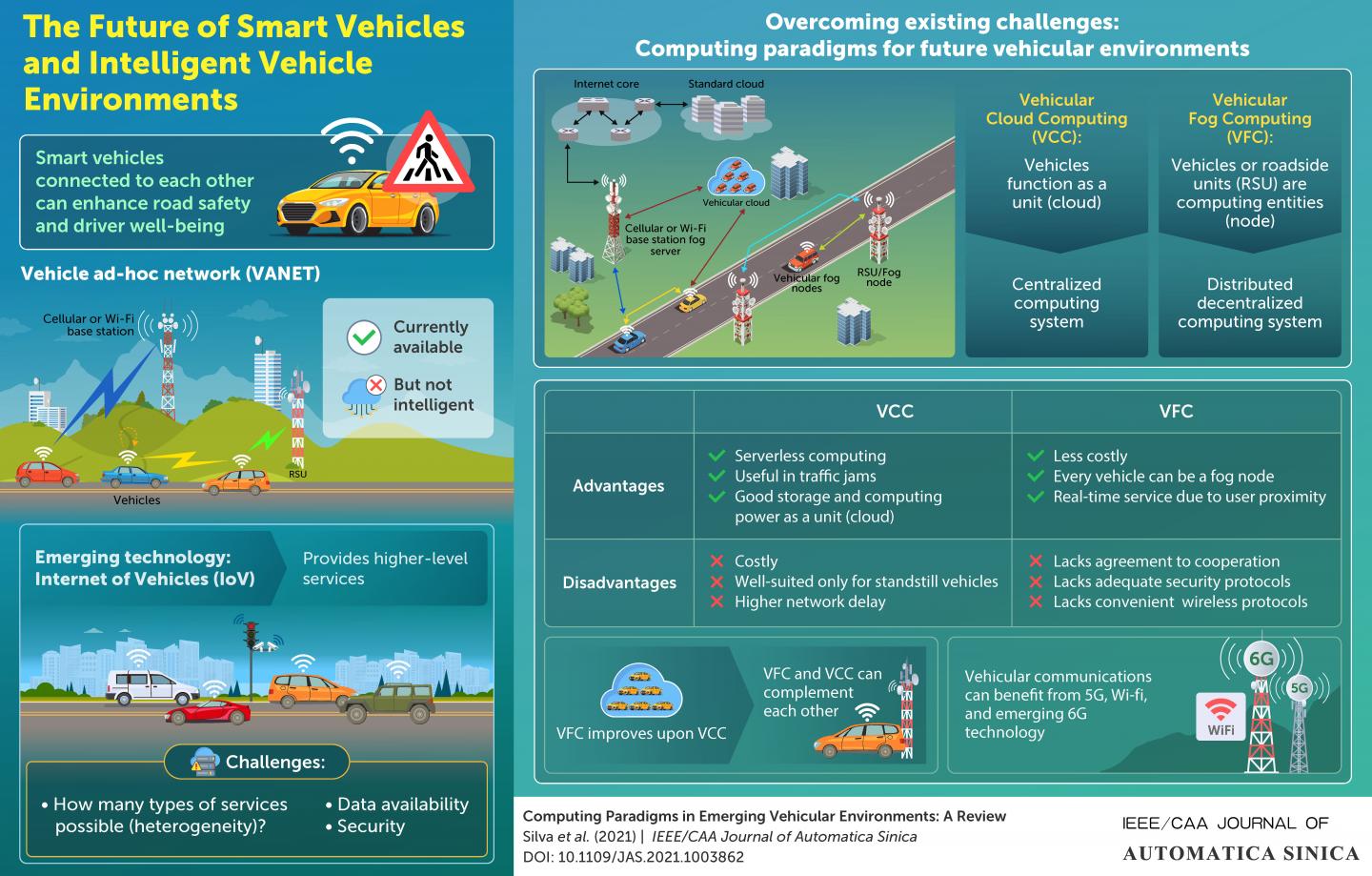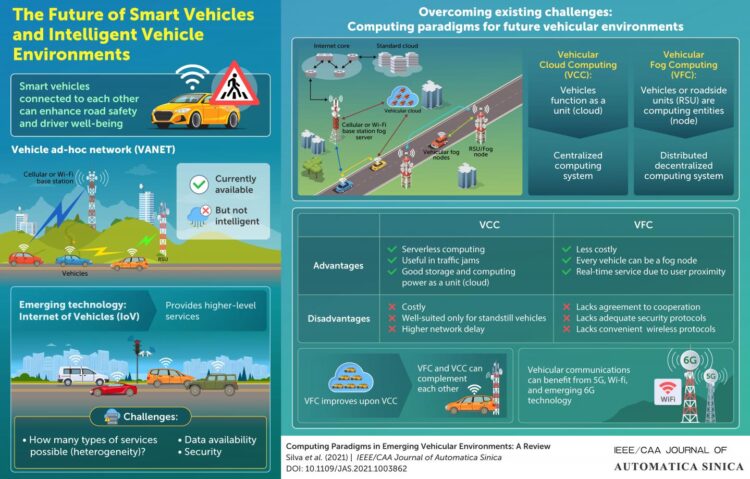Researchers explore the past, present, and future of smart vehicles and what their integration with smart cities would take

Credit: IEEE/CAA Journal of Automatica Sinica
Central to any technological progress is the enrichment of human life. The internet and wireless connectivity have done that by allowing not only virtually anyone anywhere to connect real time, but by making possible connections between humans and a range of intelligent devices both indoors and outdoors, putting smart cities on the horizon.
One key aspect of realizing smart cities is “smart vehicles”, the latest development in intelligent transportation systems (ITS), which involve the integration of communication, mapping, positioning, network, and sensor technologies to ensure cooperative, efficient, intelligent, safe, and economical transportation.
For decades, research on bringing to the streets smart vehicles that operate successfully as part of smart city infrastructure has focused on improving computing paradigms for vehicular network connectivity. Over the past 30 years, vehicular ad-hoc network (VANET), a framework where vehicles self-organize themselves to provide essential services related to road safety, has been in stable development. However, with the advent of 5G networks, VANET is soon giving way to the internet of vehicles (IoV), a novel vehicular environment with more powerful infrastructures.
“VANET was primarily conceived to inform drivers about harsh conditions or emergencies happening nearby. IoV, on the other hand, uses artificial intelligence (AI) technology to provide higher-level services such as information about traffic jams based on user location and personal preferences,” explains Dr. Naercio Magaia of the University of Lisbon, Portugal, who works on computer networks and AI, and who with a global team, has recently scoped out computing paradigms that are shaping emerging vehicular environments. Their research is published in IEEE/CAA Journal of Automatica Sinica.
IoV is in the nascent stages and there are certain crucial aspects to consider. For instance, how many different services and devices can be included in an IoV framework? How can we ensure that a user can access information most relevant to them with the least delay? And of course, how to secure a heterogeneous network with a variety of devices?
In their analysis, Dr. Magaia and team find that to naturally solve these problems, broadly, two main types of computing paradigms must be integrated and improved upon: 1) vehicular cloud computing (VCC), which is similar to cloud computing (delivery of computing services, including servers, storage, databases, networking, software, and intelligence, over the internet or “cloud”), except here, the vehicles function as the “cloud” or a “computational cluster”; and 2) vehicular fog computing (VFC), in which the computing entities (nodes) are either distributed as roadside units (RSU)–infrastructures deployed to extend vehicle coverage and network performance–or the vehicles themselves.
There are advantages and disadvantages to both these paradigms. While VCC has all the benefits of general cloud computing and is good for traffic jam situations, it is costly to apply and suffers from high network delay due to the fact that the location of the overall system is remote, making it inadequate for real-time applications. VFC, on the other hand, is cost-effective and allows real-time services because the nodes are close to the user where the service is required. It is also adaptable to a variety of requirements but lacks adequate security and convenient wireless protocols.
Dr. Magaia and team argue that for intelligent vehicular networks to be truly integrated with smart cities in real-time applications, these two paradigms must complement one another. For instance, during a traffic congestion, the vehicles can from a cloud while performing fog node computations simultaneously. Moreover, the union of next generation technological elements such as software-defined networking, 6G mobile networks, and serverless computing, with these paradigms is where the future lies.
“We believe that by 2050, with such research, billions of devices will form an internet-of-everything (IoE),” says Dr. Magaia, speaking of his vision. “Future safer driving is imperative. This kind of research is expected to revolutionize how the driver and traffic relationship around the world works. Vehicles will be “smarter”, giving more comfort to the driver and passengers. From a social perspective, vehicles become an extension of the drivers’ individuality, embedded in everyday life just as smartphones are after almost 12 years of existence as we know them.”
These times that Dr. Magaia envisions may not be too far!
###
Reference
L. Silva, N. Magaia, B. Sousa, A. Kobusi?ska, A. Casimiro, C. X. Mavromoustakis, G. Mastorakis, and V. H. C. Albuquerque, “Computing paradigms in emerging vehicular environments: A review,” IEEE/CAA J. Autom. Sinica, vol. 8, no. 3, pp. 491-511, Mar. 2021.
http://www.
https:/
IEEE/CAA Journal of Automatica Sinica aims to publish high-quality, high-interest, far-reaching research achievements globally, and provide an international forum for the presentation of original ideas and recent results related to all aspects of automation.
The first Impact Factor of IEEE/CAA Journal of Automatica Sinica is 5.129, ranking among Top 17% (11/63, SCI Q1) in the category of Automation & Control Systems, according to the latest Journal Citation Reports released by Clarivate Analytics in 2020. In addition, its latest CiteScore is 8.3, and has entered Q1 in all three categories it belongs to (Information System, Control and Systems Engineering, Artificial Intelligence) since 2018.
Why publish with us: Fast and high quality peer review; Simple and effective online submission system; Widest possible global dissemination of your research; Indexed in SCIE, EI, IEEE, Scopus, Inspec. JAS papers can be found at http://ieeexplore.
Media Contact
Yan Ou
[email protected]
Original Source
http://www.
Related Journal Article
http://dx.





